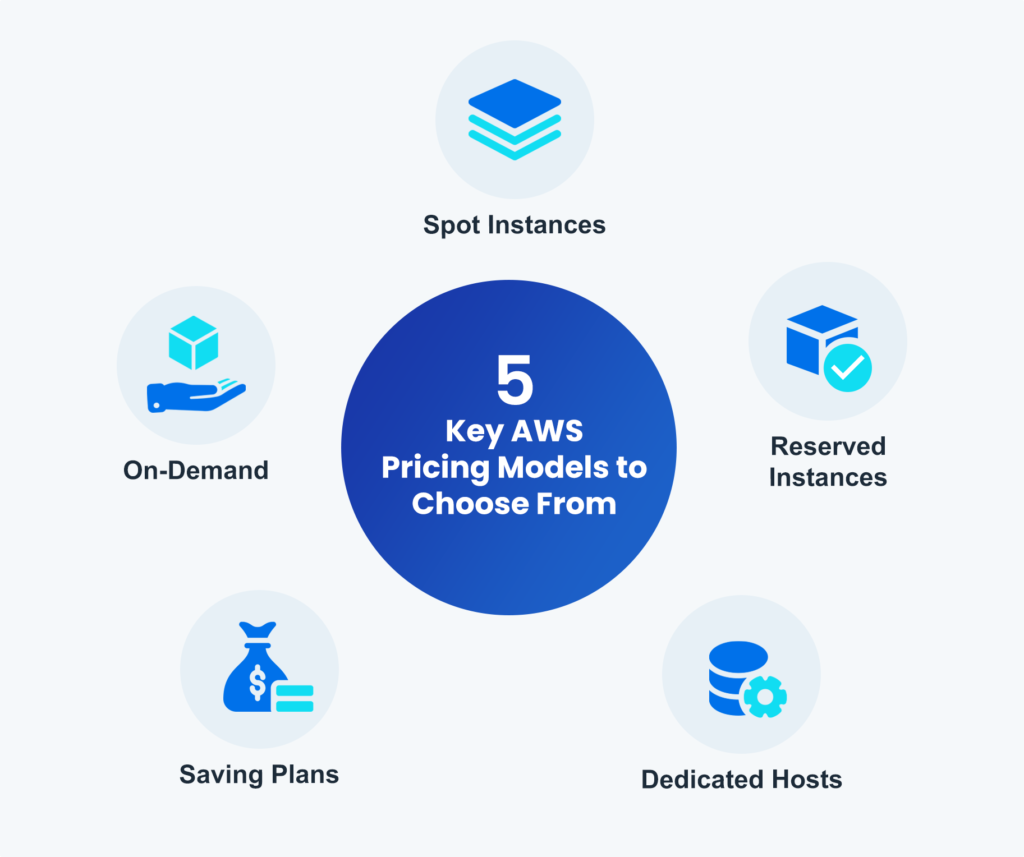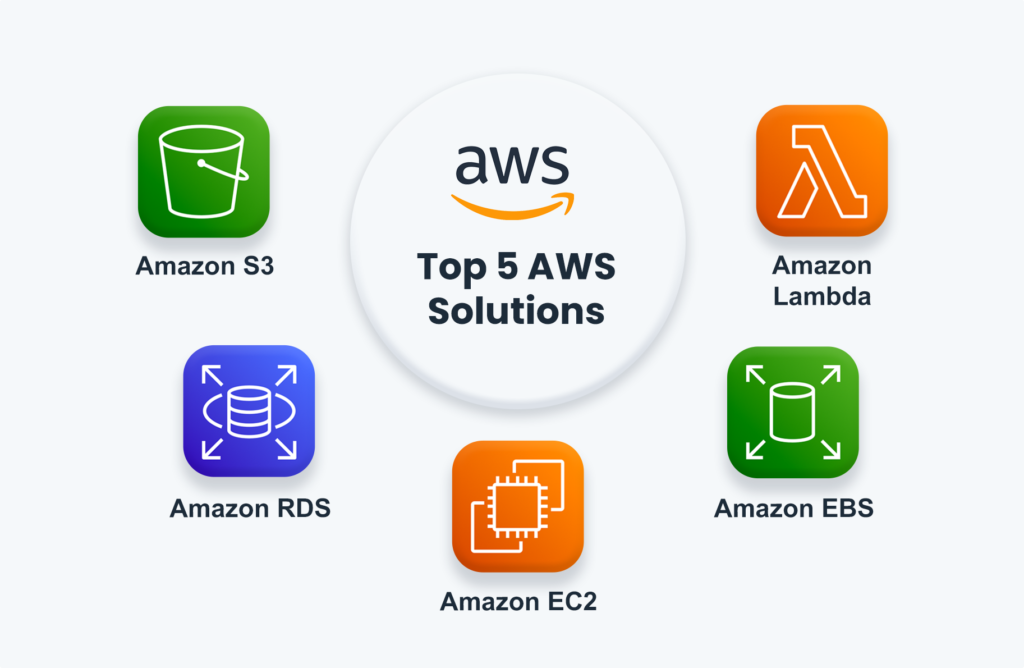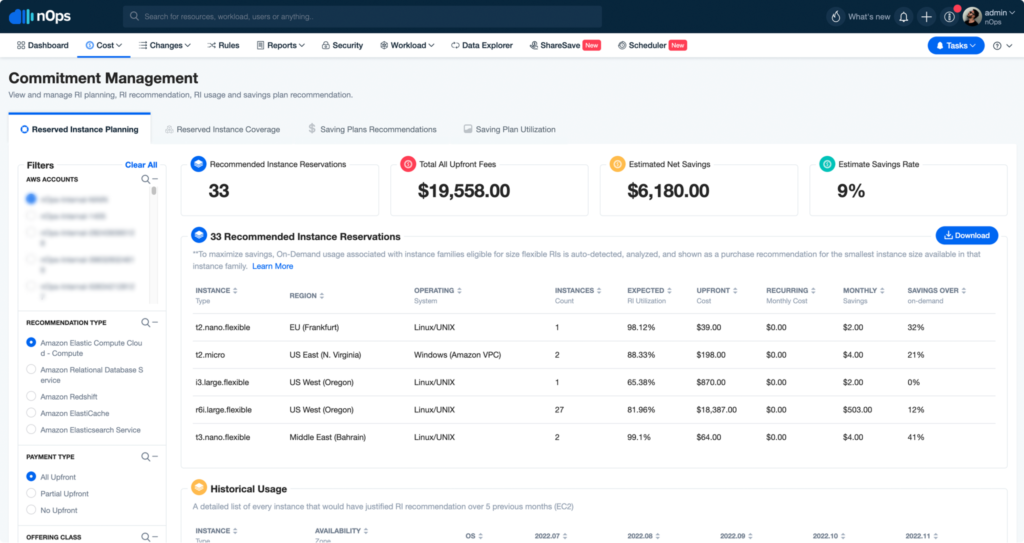Amazon Web Services (AWS) is the synonym for flexibility in the cloud infrastructure industry. With all the advantages it offers to its customers, flexibility in terms of pricing and cost structure remains at the core of the list. With numerous AWS Pricing models, businesses can choose the most optimum and feasible model to go with. If you have the sight to analyze your needs properly, your business will never pay a penny extra than your real needs with AWS. This is the beauty of on-demand pricing strategies, the pay-as-you-go model and so much more. So, to help you figure out which Amazon Web Services Pricing will be the most optimum for you here’s everything to elaborate about the AWS Pricing Principle, strategies, and Models.
5 Key AWS Pricing Models to Choose From
With AWS, your cloud computing needs are never underutilized nor overpaid, if you get the cloud requirements right. Here is how the five different pricing models vary and why you should/shouldn’t choose them:

- On-Demand
The majority of SaaS services use this pricing plan since it is the most rational. It states that you are paying again for resources you actually use daily. With AWS, you must pay for computing power by the hour or by the second. You can spin up instances using this pricing structure without making any upfront payments. When necessary, you can swiftly terminate these instances and pay for the resources you consumed. This choice offers a high level of adaptability and scalability and is perfect for new AWS users. However, your options for saving from AWS charges are restricted and if not utilized properly, this model can end up being the most expensive.
- Spot Instances
Compared to the on-demand pricing model, you can save up to 90% by using Spot Instances. The greatest potential cost savings are provided by this model, particularly when rapid scaling is required. The method is appropriate for failure-resistant processes, such as CI/CD or web servers. However, a spot instance may be terminated at any time, and you will only receive a two-minute notice before this happens.
- Reserved Instances
Reserved Instances (RIs) pricing provides significant savings of up to 72% in exchange for a lengthy commitment of one to three years. AWS provides no upfront, half upfront, and all upfront payment options for RIs. RI setup and maintenance are less difficult than with spot instances. However, you will have to pay for an instance regardless of the actual usage.
- Saving Plans
AWS Saving Plans, like RIs, provide a sizable discount in exchange for long-term commitments. In this scenario, you must make an immediate commitment for one to three years and select the cloud capability you require, calculated at a fixed price per hour. That is to say, this model is a more sophisticated example of an on-demand strategy and AWS charges, which is more predictable. However, it could be difficult to stick to commitments, and if you use resources over your allotted capacity, you will be charged on an on-demand basis only.
- Dedicated Hosts
Dedicated Hosts are real servers that you can rent through AWS. Given that you can use the complete server for private purposes, this choice is regarded as being quite safe and dependable. There are no administrative duties required while using a Dedicated Host. The hardware is totally maintained by AWS. Dedicated Hosts are more expensive, yet they are typically within the budget of large businesses.
AWS pricing for top 5 AWS Solutions/ Factors Influencing AWS pricing for top 5 AWS Solutions
Amazon pricing is typically premised on a range of factors for all its services. Although it will be nearly impossible to consider the pricing factors for all the services, here are the top 5 AWS Solutions.

- Amazon Simple Storage Service (S3)
Amazon Simple Storage Service has a much wider scope than the following factors, but here are the typical factors that determine the AWS S3 pricing. Amazon region, storage class to be implemented (Standard, Standard-Infrequently-Accessed, Intelligent Tiering, and Glacier (archive)), data requests to be processed (priced by type of request), and of course, the data to be transferred outside the Amazon region.
- Amazon Elastic Compute Cloud (EC2)
The most used service is definitely Amazon EC2. Its pricing is premised on compute instance types (General Purpose, Compute Optimized, Memory Optimized, Accelerated Computing, and Storage Optimized), the number of seconds instance is being run, and operating systems for Windows instances. The Pricing models involve On-Demand, Reserved Instance, Spot Instance, and Savings Plans.
- Amazon Elastic Block Storage (EBS)
Amazon EBS works a bit differently. The cost varies according to the amount and duration of storage used (GB per month), snapshots storage that is priced separately, amount of data to be transferred outside EC2, type of EBS volume to be employed (General Purpose SSD, Provisioned IOPS SSD, HDD) and for high performance provisioned IOPS volume (I/O Operations Per Second (IOPS)).
- Amazon Relational Database Service (RDS)
RDS is amongst the essentials that major businesses have been utilizing for years. And, the factors affecting its pricing are the database engine (MySQL, PostgreSQL, MariaDB, Oracle, SQL Server), availability zone for deployment, Instance types (General Purpose and Memory Optimized), data units to be transferred, and availability of a backup.
- Amazon Lambda
Amazon Lambda is amongst the most used services. So, its AWS Cost is premised on the number of serverless function invocations your business will be using, for the time the function is being run (priced per GB-second), availability of memory (priced per millisecond), and the provisioned concurrency.
How nOps can help in optimizing AWS costs

If you can’t access your AWS needs optimally, then these pricing techniques and models for Amazon Web Services are worthless. What if you only needed 100 units of cloud computing, but you over-forecasted 1000 units and now even the Reserved Instances plan is a void for you? I am sure you are getting how essential it is to inspect and predict your real cloud needs. And, here is this nOps ShareSave that you need. With our ShareSave solution, you can consolidate cloud accounts into a single pricing model and offer ongoing visibility to change requests. This helps you easily manage cloud costs and save more money.
Plus with nOps Cloud Cost Optimization, you can save more by centralizing cloud accounts into a consolidated billing model, providing instant and continuous visibility to change requests and delta to your infrastructure that cause cost, and giving you the best root cause analysis capabilities available anywhere.



